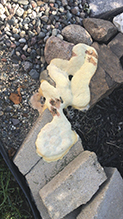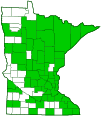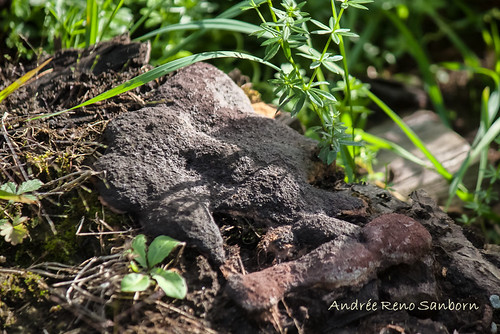Dog vomit slime mold
(Fuligo septica)
Conservation • Description • Habitat • Ecology • Distribution • Taxonomy
|
|
||||||||||||||
Description |
Plasmodial slime molds are single-celled organisms, masses of protoplasm without cell walls (naked) and with thousands of nuclei. Like animals, they move and violently eject unwanted inorganic materials. Like amoeba, they feed by engulfing particles of food. Like fungi, they reproduce by producing fruit bodies containing spores that are distributed by wind. Formerly classified as fungi, plasmodial slime molds are now known to be unrelated. Dog vomit slime mold is a plasmodial slime mold. It has a worldwide distribution, occurring on every continent except Greenland and Antarctica. It is often found in urban areas from May to October. It grows on the rotten wood of stumps, logs, and wood mulches; on garden soil enriched with manure; and also on living plants. It may migrate one meter or more to nearby food sources. It feeds on bacteria, spores of fungi and non-flowering plants, protozoa, and nonliving organic matter. Its common name accurately describes its appearance. It is not edible. Dog vomit slime mold may appear as an irregular cushion-like mass, a slimy sheet, or a crust-like sheet. When it first appears it is a white to yellow slimy sheet 1″ to 8″ (2.5 to 20 cm) long. At this stage it cannot reliably be distinguished in the field from other similar-looking slime molds. At some point the protoplasm transforms into a large, cushion-like, fruiting body (aethalium). At this stage the slime mold is easily identified in the field. The aethalium is ⅜″ to 1¼″ (1 to 3 cm) thick and may be white, yellowish, brownish-yellow, or reddish-brown. It is covered by a brittle crust. Breaking the crust away reveals a dull black spore mass. |
Similar Species |
Habitat and Hosts |
Stumps, logs, wood mulches, garden soil, and living plants |
Ecology |
Season |
May through October |
Distribution |
||
|
Sources Biodiversity occurrence data published by: Minnesota Biodiversity Atlas (accessed through the Minnesota Biodiversity Atlas Portal, bellatlas.umn.edu, 7/1/2025). |
|
| 7/1/2025 | ||
Occurrence |
||
|
||
Taxonomy |
|
Kingdom |
Protozoa (protozoans) |
Phylum |
Mycetozoa (slime molds) |
Class |
Myxomycetes (true slime molds) |
Subclass |
Columellomycetidae |
Superorder |
Stemonitidia |
Order |
Physarales |
Family |
Physaraceae |
Genus |
Fuligo |
|
|
Higher ranking |
|
Subordinate Taxa |
|
dog vomit slime mold (Fuligo septica var. candida) dog vomit slime mold (Fuligo septica var. flava) dog vomit slime mold (Fuligo septica var. rosea) dog vomit slime mold (Fuligo septica var. rufa) dog vomit slime mold (Fuligo septica var. septica) |
|
Synonyms |
|
Aethalium candidum Aethalium ferrincola Aethalium flavum Aethalium rufum Aethalium rufum Aethalium septicum ssp. flavum Aethalium septicum ssp. rufa Aethalium septicum ssp. vaporaria Aethalium septicum var. cinnamomeum Aethalium septicum var. flavum Aethalium septicum var. flavum Aethalium septicum var. rufa Aethalium septicum var. rufum Aethalium septicum var. vaporaria Aethalium septicum var. vaporarium Aethalium septicum Aethalium vaporarium Fuligo candida ssp. persicina Fuligo candida Fuligo candida Fuligo carnea Fuligo cerebrina Fuligo flava Fuligo flavescens Fuligo hortensis Fuligo ovata Fuligo pallida Fuligo rufa Fuligo septica ssp. candida Fuligo septica ssp. candida Fuligo septica ssp. cinnamomea Fuligo septica ssp. corticata Fuligo septica ssp. flava Fuligo septica ssp. rosea Fuligo septica ssp. rufa Fuligo septica ssp. rufa Fuligo septica ssp. vaporaria Fuligo septica var. alba Fuligo septica var. candida Fuligo septica var. candida Fuligo septica var. cinnamomea Fuligo septica var. flava Fuligo septica var. flava Fuligo septica var. flava Fuligo septica var. flava Fuligo septica var. flava Fuligo septica var. lapislazulicolor Fuligo septica var. rosea Fuligo septica var. rufa Fuligo septica var. rufa Fuligo septica var. rufa Fuligo septica var. vaporaria Fuligo septica Fuligo septica Fuligo septica Fuligo tatrica Fuligo vaporaria Fuligo varians var. ecorticata Fuligo varians Licea lindheimeri Mucor mucilago Mucor ovatus Mucor septicus Reticularia carnea Reticularia cerea Reticularia hortensis Reticularia lutea Reticularia ovata Reticularia rufa Reticularia septica Reticularia vaporaria Tubifera lindheimeri Tubulina lindheimeri |
|
Common Names |
|
dog vomit slime mold flowers of tan scrambled egg slime |
|
Glossary
Aethalium
The large, pillow-like, fruiting body with an outer crust of some slime molds, formed by the fusion of many plasmodia into a single functional mass. Plural: aethalia.
Plasmodum
A single-celled organism consisting of a mass of protoplasm without cell walls (naked) and with thousands of nuclei.
Visitor Photos |
||
Share your photo of this slime mold. |
||
This button not working for you? |
||
Chris Olcott |
 |
Found on bricks and mulch. |
MinnesotaSeasons.com Photos |
||
|

Visitor Videos |
||
Share your video of this slime mold. |
||
This button not working for you? |
||
|
Other Videos |
||
Slime on Mulch | Yellow Slime on Mulch | How to Get Rid of Slime Mold |
About
May 4, 2019 Slime Mold, AKA Dog Vomit or Yellow Slime, can pop up in your mulch during the hot and humid months. This fungus is very common and very normal, as it grows in organic material and thrives in hot and moist environments. While unsightly, slime mold is not dangerous to humans or animals. To learn more about slime mold, when and how to properly remove it, watch this video! |
Fuligo septica big moving plasmodium |
About
Aug 20, 2010 Big plasmodium of the Slime mold Fuligo septica, moving over dead wood. Time lapse; original time approx. 24 h Zeitraffer einer Gelben Lohblüte (Fuligo septica) in Bewegung. Es wurde alle 30 Sekunden eine Aufnahme gemacht. Die ganze Sequenz dauerte in Originalzeit ca. 24 Stunden |
Amoeba DOG VOMIT SLIME MOLD Life Cycle,Explained + Answers |
About
Aug 21, 2018 Dog vomit slime mold is an amoeba, a classification of protist (single-celled eukaryotic organism that is neither plant, animal, bacteria, nor fungus) that are amorphous in shape. They move via forming 'feet-like' pseudopodia, which are also used for feeding. This video shows it's life cycle and common questions are answered along the way and at the end. Enjoy! |
Dog Vomit Fungus |
About
Jun 10, 2019 It's that time of year again, we're starting to see the Dog Vomit Fungus pop up in mulch beds. Greg the Friendly Garden Guy talks about what to do if you have it. Join Our Email List! http://willowridgegardencenter.com/join-email-list/ Website: http://willowridgegardencenter.com/ Email: willowridge@comcast.net Facebook: https://www.facebook.com/willowridgegardencenter/ |

Created: 9/3/2020 Last Updated: © MinnesotaSeasons.com. All rights reserved. |




